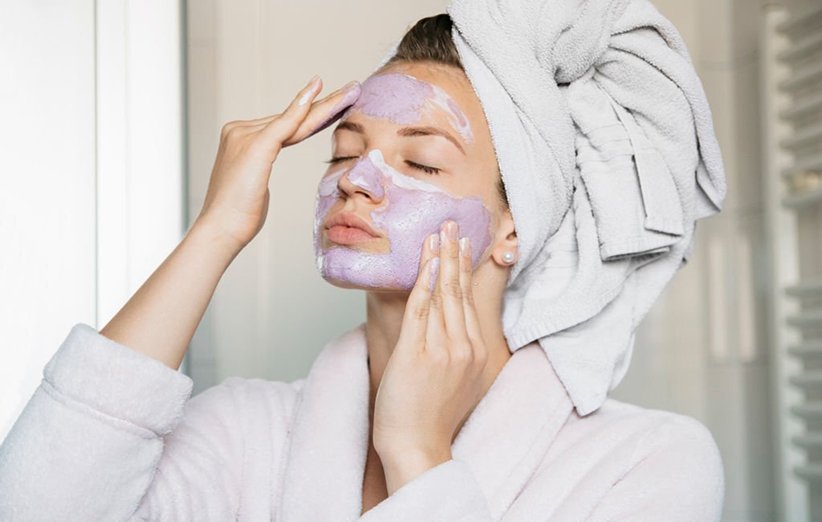3 Important Points About How to Use a Face Mask
Posted by HOOMAN MORADTALAB

3 Important Points About How to Use a Face Mask
Face masks are one of the most popular skincare products, which are produced in various forms or can be made at home using natural ingredients. There are many questions about the timing and frequency of using face masks, and the presence of conflicting answers has caused confusion for many people. Therefore, today's article is dedicated to the proper use of these popular products. Stay with us.
1.Should we use a face mask before or after taking a shower?
The answer to this question depends on the type of mask.
Face masks that are used before showering
Acne-fighting, cleansing, and exfoliating masks such as clay and charcoal masks are better used before taking a shower. After exfoliating, you can use warm water from the shower to clean the mask. This helps remove impurities, sebum, and dead skin cells from the pores of the skin.
Face masks that are used after showering
Taking a warm shower opens up the skin's pores, preparing it to absorb the active ingredients in face masks. Therefore, moisturizing and anti-aging masks that need to penetrate deep into the layers of the skin are better used after taking a shower. In addition, using these masks after taking a shower helps to maintain skin moisture and makes it softer.
2.Can we use a face mask every day?

It is not recommended to use a face mask every day as it can lead to skin irritation and dryness. It is best to use a face mask once or twice a week, depending on your skin type and the type of mask you are using. Overuse of face masks can strip the skin of its natural oils and cause more harm than good.
These days, there is a wide variety of facial masks available. Therefore, the type of mask affects how many times it can be used.
Sheet facial mask
Sheet masks contain ingredients that can help improve and heal the skin in various ways. They are incredibly hydrating, but only as long as they are wet. When a sheet mask dries up, it can pull all the mineral and vitamin-rich essence out of your skin. Additionally, some sheet masks may contain chemicals.
While using sheet masks on a daily basis may seem tempting, experts do not recommend it because some of the ingredients present in these masks can clog pores. Therefore, it is better to use sheet masks once a week.
Charcoal masks
Charcoal masks are very useful for cleaning impurities from the skin and getting rid of blackheads and whiteheads. However, they can be harsh for your skin. It is undeniable that activated charcoal is an excellent cleanser and can remove bacteria, impurities, and toxins from the pores, but the problem is that it can also strip away the skin's natural oils. Therefore, using it can increase the vulnerability of the skin to all the pollutants present in the air. As a result, it is recommended to use charcoal masks once a month, no more.
Clay Mask
Clay masks are usually suitable for all skin types and do not irritate the skin. Depending on the type of clay you use, these masks can combat acne, skin blemishes, and signs of aging caused by sun damage. They can also remove excess oil from your face. However, daily use of them can damage the skin. Depending on your skin type, you can use clay masks once or twice a week.
Tea Mask
One of the best options for improving skin health is a tea face mask. This mask not only fights signs of aging but also neutralizes free radicals and helps prevent acne and pimples. However, the tea mask should not be used more than once a week.
Peel-off masks

Peel-off masks are excellent for removing dead skin cells, whiteheads, and blackheads. However, excessive use of these masks can harm your skin. Therefore, use these masks at most once every two weeks.
Homemade masks
Homemade masks can contain various ingredients such as turmeric, yogurt, aloe vera, coconut oil, clay, and rose water. Due to the naturalness of these ingredients, you can use homemade masks up to three times a week. However, be careful if you use citrus fruits (such as lemon juice). Do not leave the mask on your face for too long.
The Effect of Skin Type on Mask Usage Frequency
The frequency of using face masks depends on the type of skin.
Acne-prone skin
Acne-prone skin is usually oily, so it is necessary to prevent excessive sebum production. You can use homemade masks containing turmeric and rosewater, but daily use may dry out your skin and reduce its ability to produce natural oils. The best solution is to use a mask once every other day and keep your skin hydrated with a suitable moisturizer.
Dry skin
Hydrating masks work best for dry skin. If you have dry skin, you can use a gentle and hydrating face mask about three to four times a week.
Oily Skin
If you have oily and acne-prone skin, charcoal and clay masks are the best option for you. Acne treatment masks usually contain ingredients such as salicylic acid and benzoyl peroxide. If you use these products every day, they may irritate your skin. It is better to limit the use of these masks to one to two times a week.
Sensitive Skin
If you have sensitive skin, you should be more careful about masks and their ingredients. Just like people with dry skin, you can use hydrating masks up to three times a week. The important point is to avoid buying masks containing chemicals and artificial fragrances.
3.What is the best way to use a face mask?

Regardless of the type of mask, follow these steps to use it:
- Step 1: Use a gentle cleanser to clean your face.
- Step 2: Apply a thin layer of the mask to your entire face and neck using a soft brush. Avoid contact with your eyes and lips.
- Step 3: If using a peel-off mask, gently massage the skin in circular motions for a few minutes.
- Step 4: Wait for 15 to 20 minutes for the mask to dry. Generally, masks designed for oily skin should be left on for a shorter period, while anti-aging and moisturizing masks should be used for a longer time.
- Step 5: Depending on the type of mask, you may need to wash your face after using it. Use warm water to wash off the mask. You can also use a soft washcloth to make cleaning easier.
- Step 6: After half an hour, you can continue with your regular skincare routine.
Always follow the instructions written on the packaging when using a face mask. Face masks often contain active ingredients that should not be left on the skin for a long time, as they can be harmful to the skin.
If you are using homemade masks with natural ingredients, you can leave them on your face until you want or until they dry. However, be careful if you use citrus fruits to make homemade masks because they can irritate your skin. These masks should not be left on the skin for more than 20 minutes. If you have sensitive skin, do not use homemade masks containing citrus fruits.
Final words:
Overusing facial masks can disrupt the pH balance of the skin and strip away its natural oils. The frequency of using facial masks and the best time to do so depends on the type of mask and your skin type. Generally, it is recommended to use moisturizing or anti-aging masks after taking a shower and use exfoliating or anti-acne masks before taking a shower.
In addition, weather conditions and seasons should also be taken into consideration when using a facial mask. For example, your skin gets dry in the winter, so a clay mask is not suitable for use during this season. During the cold seasons, your skin needs a moisturizing and hydrating facial mask.



